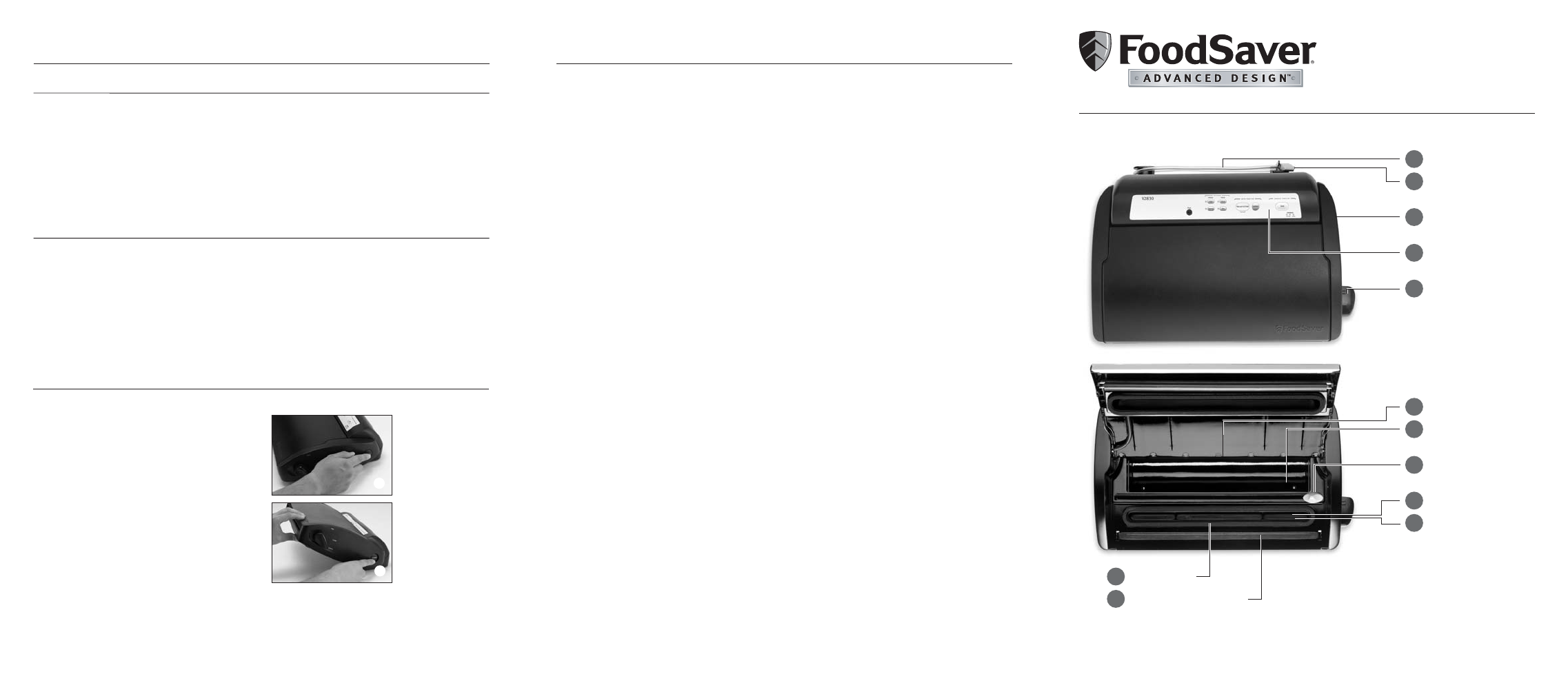
Featur es
For important safety information and helpful tips,please refer to the FoodSaver
®
Reference Guide
included in your kit.Questions? Visit us at www.foodsaver.com or call 1-800-777-5452 (U.S.) or
1-877-804-5383 (Canada).Get tips on vacuum packaging and order FoodSaver
®
accessories.
Accessory Hose
Accessory Hose
Storage
Flip-up Release
Button
Touchpad Control
Panel
Easy-lock Latch
E
D
C
B
A
Pen Storage
Roll Storage
Compartment
Bag Cutter and
Cutter Bar
Easy-clean Drip Tray
Vacuum Channel
J
I
H
G
F
Foam Gasket
Extra-wide Sealing Strip
L
K
Features of Your FoodSaver
®
Appliance
Tips
Tips for Successful Vacuum Packaging
For more usage tips and safety information, please refer to the FoodSaver
®
Reference Guide or visit our website at www.foodsave r.com.
Make sure appliance lid is securely latched.
When making a bag from a roll,place bag material on
Sealing Strip
(L), close lid and make sure to use the
Latch
(E) to lock lid.Then press Seal Button (T).
Prevent moisture or liquid from being pulled into
the Vacuum Channel
(J) or trapped in the seal.
Either pre-freeze moist food such as raw meat for 1-2
hours before vacuum packaging,or place a folded paper
towel between food and end of bag to absorb excess
liquids.Just be sure to leave at least 3 inches between
paper towel and end of bag so that bag seals properly
with paper towel inside.
Make sure appliance has time to cool down.
Wait at least 20 seconds between seals. Under very
heavy usage,appliance will not operate to prevent
overheating.If it does, wait 20 minutes to allow
appliance to cool off.
Tips on Removing Air from a Bag
Make sure appliance lid is securely latched.
When vacuuming and sealing a bag, make sure the
Latch
(E) is in the locked position.
Check for wrinkles in the bag along the Sealing
Strip
(L).Wrinkles in seal may cause leakage and allow
air to come back into bag. Check for wrinkles in bag
along Sealing Strip before closing lid and vacuum
packaging.If you find wrinkles after sealing bag,simply
cut bag open and vacuum package again.
If motor runs for more than 30 seconds without
stopping, consider the following: If vacuum packaging
with a bag, make sure open end is placed down inside
Vacuum Channel
(J) and make sure Accessory Hose (A)
is not attached. If vacuum packaging with an accessory,
check Accessory Hose in appliance lid and in accessory
to ensure a tight fit.
Tips on Storage
To utilize flip-up storage:
1. Close the lid.
2. Turn Latch
(E) halfway to secure for storage
(the halfway position locks appliance lid for storage
without compressing the foam gasket and creating
unnecessary wear and tear).
3. Push and hold Release Button
(C) on the right side
of appliance.
4. Raise the front of appliance until it is in the upright
position and clicks.
5. Let go of the Release Button.
6. When ready to use again,press Release Button and
lower front of appliance.
General Tips
Tips for Successful Vacuum Packaging
(continued)
1. Vacuum packaging is NOT a substitute for the
heat process of canning.Perishables still need to
be refrigerated or frozen.
2. For best results, use FoodSaver
®
Bags, Canisters
and Accessories.
3. During the vacuum packaging process,small
amounts of liquids, crumbs or food particles can
be inadvertently pulled into Vacuum Channel
(J),
clogging the pump and damaging your appliance.
To prevent this, follow these tips:
a. For moist and juicy foods such as raw meats:
Freeze first and avoid over filling bags.You can
also place a folded paper towel inside top of bag,
but below seal area,before vacuum packaging.
b. For soups, sauces and liquids: Freeze first and
avoid over filling bags. Or, use a canister in
refrigerator.
c. For powdery or fine-grained foods: Avoid
over filling bags or use a canister.You can also
place a coffee filter or paper towel inside
before vacuum packaging.
d. If your appliance features a Drip Tray (I),
empty after each use.
4. To avoid over filling,always leave at least 3 inches
of bag material between bag contents and top of
bag.Then leave at least one additional inch of bag
material for each time you plan to reuse bag.
5. Do not create your own side seams for a
FoodSaver
®
Bag.These bags are manufactured
with a special side seam, which is sealed all the
way to the outer edge.
6. To prevent wrinkles in a seal when vacuum
packaging bulky items, gently stretch bag flat
along Sealing Strip
(L) before you close lid.
7. If you are unsure your bag was sealed properly,
simply reseal bag about
1
⁄
4
inch above first seal.
8. When you are vacuum packaging items with
sharp edges (dry spaghetti, silverware, etc.),
protect bag from punctures by wrapping item in
soft cushioning material, such as a paper towel.
You may want to use a canister or Mason jar
instead of a bag.
9. When using accessories, remember to leave one
inch of space at top of canister or container, and
make sure to lock Latch
(E) before vacuuming.
Unlock the Latch when finished.
10.Pre-freeze fruits and blanch vegetables before
vacuum packaging for best results.See pages
2-3 of FoodSaver
®
Reference Guide for more
information.
11.If appliance does not function,check to make
sure the Latch
(E) is in the locked position.
12.If storing appliance horizontally, make sure
the Latch
(E) is in the unlocked position. If
storing appliance vertically,lock the Latch
halfway,to the store position. Make sure
Drip Tray
(I) has been emptied before
storing vertically.
© 2007 Sunbeam Products,Inc.doing business as Jarden Consumer Solutions. All rights reserved.
First Printing:12/2006
QuickStart
V2830
3
4
Tips on Sealing a Bag
Item # T180-00130 (12/06)
FSR1630



